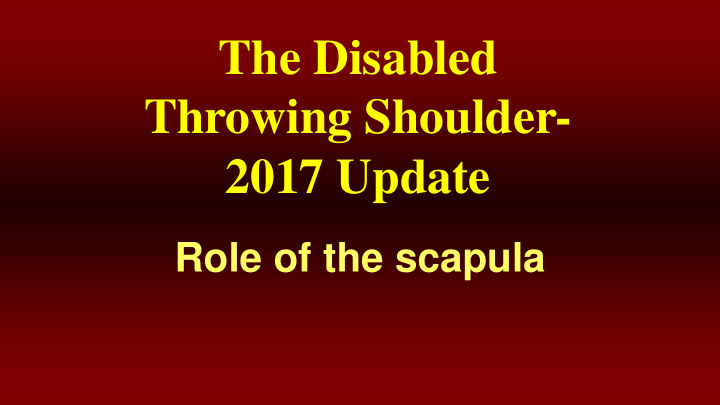



The Disabled Throwing Shoulder- 2017 Update Role of the scapula
W. Ben Kibler, MD Medical director
W. Ben Kibler, MD Shoulder Center of KY Disclosure Disorders of the Scapula and Their Role in Shoulder Injury
Scapular roles • Mobile but stable platform for muscle action throughout shoulder ROM • Congruent socket for dynamic ball/socket kinematics • Link in kinetic chain- force transfer (core> arm), control at joints
THE KINETIC CHAIN Force delivery Force regulation, transfer Force generation
Scapular dyskinesis- 1 • Dyskinesis as an impairment of optimal scapular/arm function • Potential to affect scapular roles in shoulder/arm function, SHR – Static position, dynamic motion – Muscle strength, joint mobility Kibler et al BJSM 2013
Scapular dyskinesis- 1 • Dyskinetic shoulders- 43% increased risk of subsequent injury – Hickey et al BJSM 2017 • Dyskinetic shoulders fail earlier under the same exposure, load • Evaluation in asymptomatic athletes
Dyskinesis/labral injury • Dyskinesis- 94%- clinical labral injuries • Risk factor in “cascade to injury” • Protracted scapula • Labral/rotator cuff compression- ABER • Labral shear with arm rotation • “Internal impingement”
Scapular dyskinesis- 2 • Associated with symptomatic shoulders • 67- 100%, all pathology • ? Cause, effect- part of altered anatomy, physiology, mechanics • Evaluate, treat as needed
Dr S Yoo Biceps/labral complex pressure 5 degree anterior scapular tilt 30MPa 158MPa
Scapula Orientation Upward rotation Internal rotation Anterior tilt 30º 10º 30º 40º 40º 0º 20º 20º T Mihata
What affects internal impingement? Decreased upward rotation Internal impingement Increased area Increased internal rotation Internal impingement Increased area and pressure T Mihata
Scapular External Rotation Non-Injured Injured External Rotation Humeral Elevation (degrees)
Scapular Upward Rotation Non-Injured Injured Upward Rotation Humeral Elevation (degrees)
Dyskinesis/labral injury • Clinical prediction process • Proven labral injury • Predictors for failure of PT, need for surgery – Painful arc, protracted scapula Kibler, Arthroscopy 2013
SCAPULAR EXAM - Establish presence/absence of dyskinesis - Effects of corrective maneuvers - Assess causative factors
Clinical observation • Position – medial border • Motion – dyskinesis patterns: I (inferior medial), II (medial), III (superior medial) – yes/no • 3-5 reps, flexion, 3-5 lb wt
“Yes/No” • “ Yes”/“No” seen/not seen • Specificity-.64,sensitivity- .82/(+),PV-.84- bone • Clinically useful, similar to other shoulder exam tests • Uhl et al Arthroscopy 25(11): 1240-1248, 2009
EVALUATION • Corrective maneuvers – Scapular Assistance Test (SAT) • Assist scap upward rotation/posterior tilt • (+)- Relief of external impingement sx – Kibler et al AJSM,1998 – Rabin et al, JOSPT, 2006
EVALUATION • Corrective maneuvers – Scapular Retraction Test (SRT) • Assist scapular external rotation/posterior tilt • (+)- Inc rot cuff strength, relief-int impingement – Kibler et al AJSM 1998 – Kibler et al AJSM, 2006
EVALUATION - Checklist of causative factors - Bony- fx, separation - Joint- labral, rot cuff, biceps - Muscular- weakness, inhibition, imbalance, injury - Neurological
Dyskinesis- nonoperative Pect Minor tightness Upper trap Altered GH tightness, rotation- IR, ER weakness Arthritis Lower trap Lat dorsi weakness, tightness inhibition Serratus anterior Core weakness, weakness, inhibition dec facilitation
Dyskinesis- operative Pect Minor tightness Fx clavicle, Long thoracic, AC joint injury accessory nerve injury GH joint injury- labral, biceps, Scapular rotator cuff, muscle arthritis detachment Snapping scapula
Conclusions • Scapula position/motion key to shoulder function/injury • Dyskinesis- affects symptoms • Evaluation for dyskinesis in all shoulder injuries • Scapular restoration as part of shoulder treatment
Considerations in rehabilitation of scapular dyskinesis
Scapula factors • Scapular dyskinesis • Loss of dynamic scapular retraction control • Multiple factors • Commonly- “lower trapezius deficiency syndrome”
Scapula factors • Lower trapezius “turned off” • Dec low trap activation – Inc up trap activation – Inc latissimus activation – Tightness- ant muscles- pect minor, biceps, neck
Scapula factors • Turn on low trap activation • No inc up trap activation • Stay below impingement • Include kinetic chain activation to maximize scapular muscle activation
Scapular rehab • Muscle activations – Serratus- ext rotation – Low trap- stabilizer in retraction – Rhomboids- stabilizers – Up trap- minimal early
Scapular retraction • Scapular stability series – Low row, lawnmower, robbery, fencing, glide – Early in sequence – Low loads – Arm below impingement
Isometric Exercises Inferior Glide Low Row
Dynamic Exercises Robbery Lawnmower
Kibler, WB; Sciascia, AD; Uhl, TL et al, AJSM 39(6): 1789-1798, 2008
Ellenbecker and Cools BJSM
References • Burkhart S et al. The disabled throwing shoulder, spectrum of pathology, Arthroscopy 2003 • Kibler et al. The DTS, 10 year update. Arthroscopy 2013 • Thomas S et al. The scapula and the throwing/ overhead athlete, in Disorders of the scapula and their role in shoulder injury, Springer 2017
THANK YOU www.shouldercenterofky.com
Recommend
More recommend